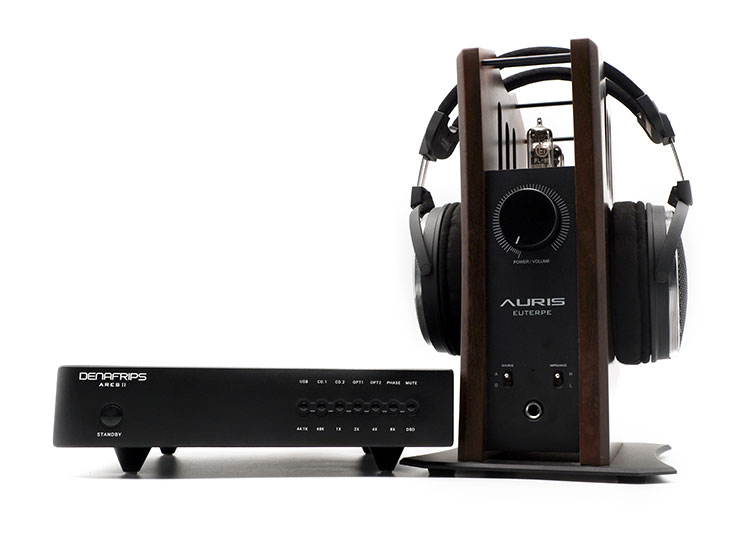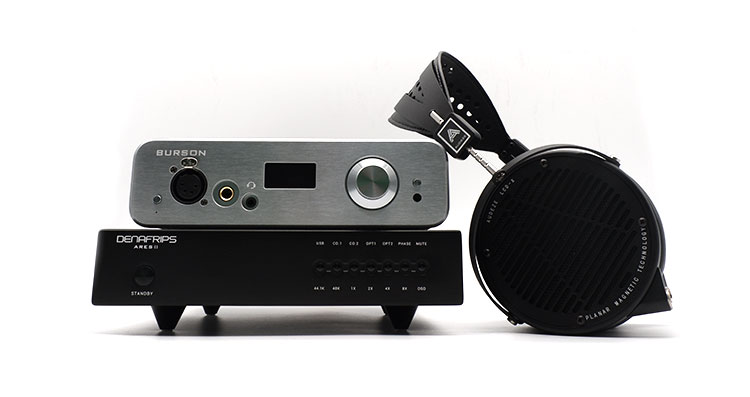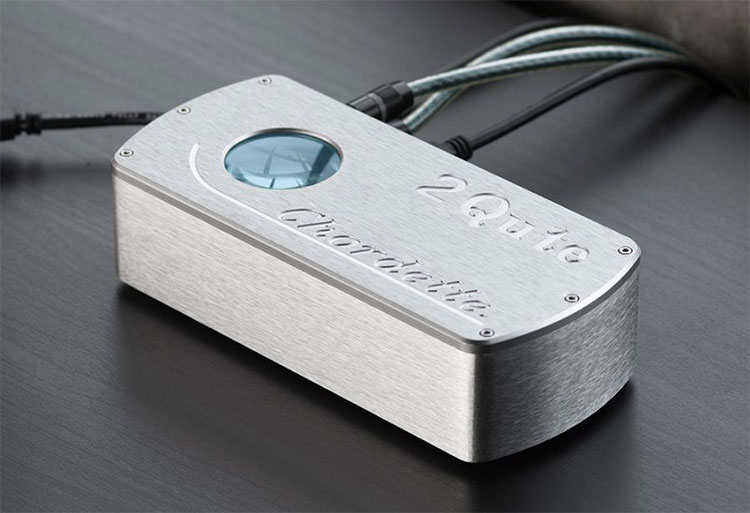Synergy
Swapping the Ares II into my main system, I was able to test the Ares II both with my Burson Soloist 3X connected to my LCD-X, as well as my Auris Audio Euterpe connected to my Audio Technica ADX-5000. With these setups, the Ares II’s gentler nature complemented both systems quite well.
Auris Audio Euterpe + Audio Technica ADX-5000
Pairing the Euterpe and the ADX-5000 with the Ares II on OS mode, the pairing is great for more classical and orchestral recordings. Although the Ares II and the ADX-5000 are both on the thinner side of neutral, the slight girth provided by the Euterpe balanced out the wispiness of both the DAC and the headphones.
Furthermore, the Ares II also accentuated the ADX-5000’s ability to present vast orchestral recordings, where the Ares II just magnified this a bit more.
With tracks that may require a bit more grunt though, like rock or the more compressed nature of modern pop, the Ares II on OS mode makes the entire chain slightly limp. However, switching the Ares II over to NOS mode gives it a richer tone, and a bit more girth in the mid-bass region while still retaining the energetic but measured treble response and the euphonic midrange.
Burson Soloist 3X + LCD-X
With the Burson Soloist 3X and LCD-X pairing, the gentler nature of the Ares II on OS mode gave the LCD-X a touch more speed and airiness that it sorely needs. The gentler nature of the Ares II is also supplemented well by the pairing since both the amp and the headphone have a slightly more impactful nature.
The LCD-X is generally an intimate headphone, with a fair bit of accuracy in image directionality and layering. The Ares II’s slightly expansive nature gives the LCD-X a touch more airiness and a sense of vastness.
While orchestral recordings have a better sense of scale on the previous pairing, the Soloist 3X and the LCD-X still produced a more expansive sense of scale than they normally do.
Furthermore, this pairing also does a bit better with genres like rock, which may require a bit more punch and slam, with the Ares II providing a better sense of dimensionality and scale. Modern pop music also does a bit better with this pairing, since this setup tends to shy away from being too bright most of the time.
Select Comparisons
Cayin iDAC-6 MK1
Design
Physically, the Cayin iDAC-6 is slightly larger than the Ares II, with the Ares II being an inch narrower, but about an inch deeper. So both devices will practically take up the same space on a desk. When I lifted both devices, I thought that the iDAC-6 is surely significantly heavier, however, the Ares II weighing 3kg, is only 0.7kg lighter than the iDAC-6. So it’s pretty much the same.
The Ares II uses a more standard steel chassis, while the iDAC-6 uses a thicker aluminum chassis that feels substantially more solid.
However, the thicker aluminum chassis turned out to be an absolute necessity for the iDAC-6 because the aluminum chassis doubles as a heat sink to a DAC that runs really hot after just 10 minutes of continuous use. The Ares II in contrast only runs warm even with the DAC running continuously on for 10 days.
The Input options available on the 2 DACs are pretty similar, with both having USB, optical, and coaxial. However, the iDAC-6 has an option for AES/EBU. The available outputs on the 2 devices are also the same, with both having a pair of RCA outputs, and a pair of 3-pin XLR balanced outputs.
While the outputs on the Ares II are fixed, the output for the iDAC-6 can either be line level out or be switched into a pre-out mode that can be controlled by the volume knob in front of the unit.
Technical
The Ares II is more future-proofed when it comes to its decoding capability, topping out at 24bit/1536kHz with PCM and DSD1024. The iDAC-6 on the other hand has a more standard 32bit/384kHz PCM, and DSD128 limit. In practice though, both DACs are still capable of decoding the music that is currently available at the moment.
The Cayin iDAC-6 came out a few years ago, so it’s equipped with a DAC chip that is a bit more dated in the AK4490 DAC chip. The iDAC-6 however sports 2 of these chips, so that the DAC can output a pure balanced signal.
However, what’s special about the iDAC-6 is that it’s equipped with a tube output stage available at the balanced output of the DAC. With the difference in the technologies implemented in the 2 DACs, it’s interesting to hear how the 2 would differ sonically.
Performance
Starting from the bass region, both DACs are equally extended in the sub-bass region while still being neutral. Drum hits are quite different between the 2 though, with the Ares II having a more immediate sense of attack, while the iDAC-6 is a more full-bodied experience.
Bass guitars have a richer quality on the iDAC-6, while the Ares II presents bass guitars with a bit more accuracy while still having more natural harmonic overtones.
The midrange on the iDAC-6 is generally richer as well, where vocalists have a thicker more syrupy character. While the Ares II is just more honest, but extremely clean.
The treble range on the Ares II is actually a bit sharper when compared to the iDAC-6. Where the iDAC-6 tends to make treble notes a bit smoother, the Ares II has a clean and accurate treble that sounds highly detailed but never too bright.
The soundstage on the Ares II is significantly wider and more expansive. The images created with the Ares II are on the wider side most of the time, while the iDAC-6 typically presents the images more intimately. Both DACs are layered though, so the iDAC-6 can still push images further out if necessary, but never as much as the Ares II.
With the gentler nature of the Ares II, it typically has a better sense of dynamic range presenting a gentler passage with more refinement and apparent detail retrieval. The iDAC-6 on the other hand is slightly thicker, so gentler passages are slightly louder and less wispy. Both DACs present crescendos with the same emotional engagement though.
Chord 2qute
Design
When it comes to the form factor, the 2qute is just cute compared to the Ares II. The 2qute takes up just ¼ the desk space when compared to the Ares II. It also weighs substantially less, but it requires an external power brick, while the Ares II is compatible with standard IEC power cables.
In terms of I/O, the 2 devices are quite similar, with both having options for USB, optical and coaxial. Except that the 2qute uses a BNC connector for the coaxial input, but a BNC to RCA converter is quite common.
The output on the 2qute is limited to a pair of single-ended RCA outputs, while the Ares II has both RCA and balanced outputs. It’s worth noting though that the 2qute’s RCA outputs have a line-level output of 3V, instead of the standard 2V output of most RCA outputs like in the Ares II, so volume matching is a must when comparing the 2 DACs.
The interface on the 2qute is very simple, where the only way to interact with the DAC is the single button at the back that switches between the 3 input options. The 2qute is always on as long as it’s plugged in so there’s no power or standby button, unlike the Ares II.
The signal resolution is displayed by the colors on the viewing window of the 2qute, which takes more getting used to compared to the more straightforward system of LEDs on the Ares II.
Technical
The 2qute is limited to sampling rates of 32bit/384kHz PCM, and DSD128, while the Ares II can decode at much higher rates with 24bit/1536kHz PCM and DSD1024. While the Ares II is more future-proof, both DACs can still decode most files that are available in the market today.
The Ares II employs a more traditional R2R approach to its DAC design, while the 2qute utilizes an advanced form of delta-sigma DAC.
Inside the 2qute, Chord uses an FPGA chip with a 26,368tap WTA filter to interpolate the data between each sample in a music stream. This results in a higher perceived resolution on the DACs output side, which can increase the accuracy of timing information for a more natural sound.
Performance
Like most DACs at this price point, both the 2qute and the Ares II strive to have a flat frequency response, and generally, they both achieve it. In the bass region, both DACs extend down into the sub-bass well.
However, the 2qute has a more impactful and thicker presentation. The Ares II on the other hand has a more textured and gentler approach to its presentation while still having a good sense of attack and decay.
The midrange on the 2qute is a bit thicker and presents vocals with a bit more authority. This also ends up giving vocals a richer and more intimate presentation.
In contrast, Ares II’s vocal presentation is a bit more textured and layered. When playing piano tracks, the Ares II tends to have a more natural harmonic balance, while the 2qute can have a tendency towards sibilance at times.
Treble is slightly more crisp on the 2qute, but this may end up being a detriment on tracks that are not as well recorded. The Ares II on the other hand has a cleaner and more natural treble response that is very detailed but never sibilant. With the air frequencies, the Ares II is a bit airier than the 2qute, which gives the soundstage a slightly more expansive feel overall.
Staging
The first thing that I noticed when switching from the 2qute to the Ares II is that the Ares II is considerably more expansive. Not that the elements play further away from you, but the Ares II feels like it’s playing in a larger room.
The directionality of the images formed by both DACs is equally accurate. However, when it comes to layering and instrument separation, the 2qute is just a hair more separated.
Switching on the NOS with the Ares II creates a middle ground between the 2qute’s more authoritative and intimate presentation, and the Ares II on OS mode’s gentler, and more expansive presentation.
Our Verdict
The Denefrip Ares II doesn’t have much in the way of a fancy screen or anything that makes it look “hi-tech”. In fact, it looks slightly retro with the classic approach of having a lot of physical buttons and LED lights with multiple functions.
However, this is a versatile little device, with the ability to accept the standard input options USB, coaxial, and optical as well as single-ended and balanced output options.
The option to switch from OS to NOS also gives Ares II the ability to adapt and enhance a wider variety of systems. All while having the ability to decode PCM up to 24bit/1536kHz, and native decoding up to DSD1024.
The sound is wide and natural with defined layering and neutral tonality. The Ares II’s attributes are not dripping in obvious coloration rather it has a beautifully natural sound that makes it easy to enjoy whilst still being strikingly accurate and detailed.
Denafrips Ares II Specifications
- Proprietary R2R + DSD Architecture
- True balanced 24BIT R2R + 6BIT DSD (32 steps FIR Filters)
- Native DSD decoding with 0.01% precision resistors
- FEMTO Crystal 45.1548MHz, 49.152Mhz
- Low Noise Power Supply
- Digital Signal Processing via FPGA
- Adaptive FIFO Buffer and Reclocking
- DSD1024, PCM1536 Supports On USB Input
- Proprietary USB Audio Solution via STM32F446 Advanced AMR Based MCU
- Licensed Thesycon USB Driver For Windows Platform
- Driverless On Mac & Linux
- DSD64-DoP On All Input
- DSD1024* On USB input
- PCM 24bits / 44.1, 48, 88.2, 96, 176.4, 192KHz On All Input
- 1536kHz* On USB Input
- NOTE* USB Firmware V3.4.1 – PCM1536 / DSD1024 supports disabled for compatibility with macOS
- Digital Input Coax x 2, Toslink x 2, USB,
- Analog Output RCA at 2.0Vrms, 625 Ω
- XLR at 4.0Vrms, 1250 Ω
- Sampling Mode Non-Oversampling NOS / Oversamping OS
- Filter Selection Slow / Sharp
- AC Power Requirement 100-240VAC, 50/60Hz (Worldwide Voltage, Manual Selector)
- Power Consumption ≤20W
- Frequency Response 20-70KHz -3dB
- THD+N 0.004%
- S/N Ratio 115dB
- Dynamic Range >119dB
- Stereo Crosstalk -124dB
- Dimension 215 x 230 x 45 mm
- Weight 3.5 Kg
- Color Black
- Warranty 36 Months







